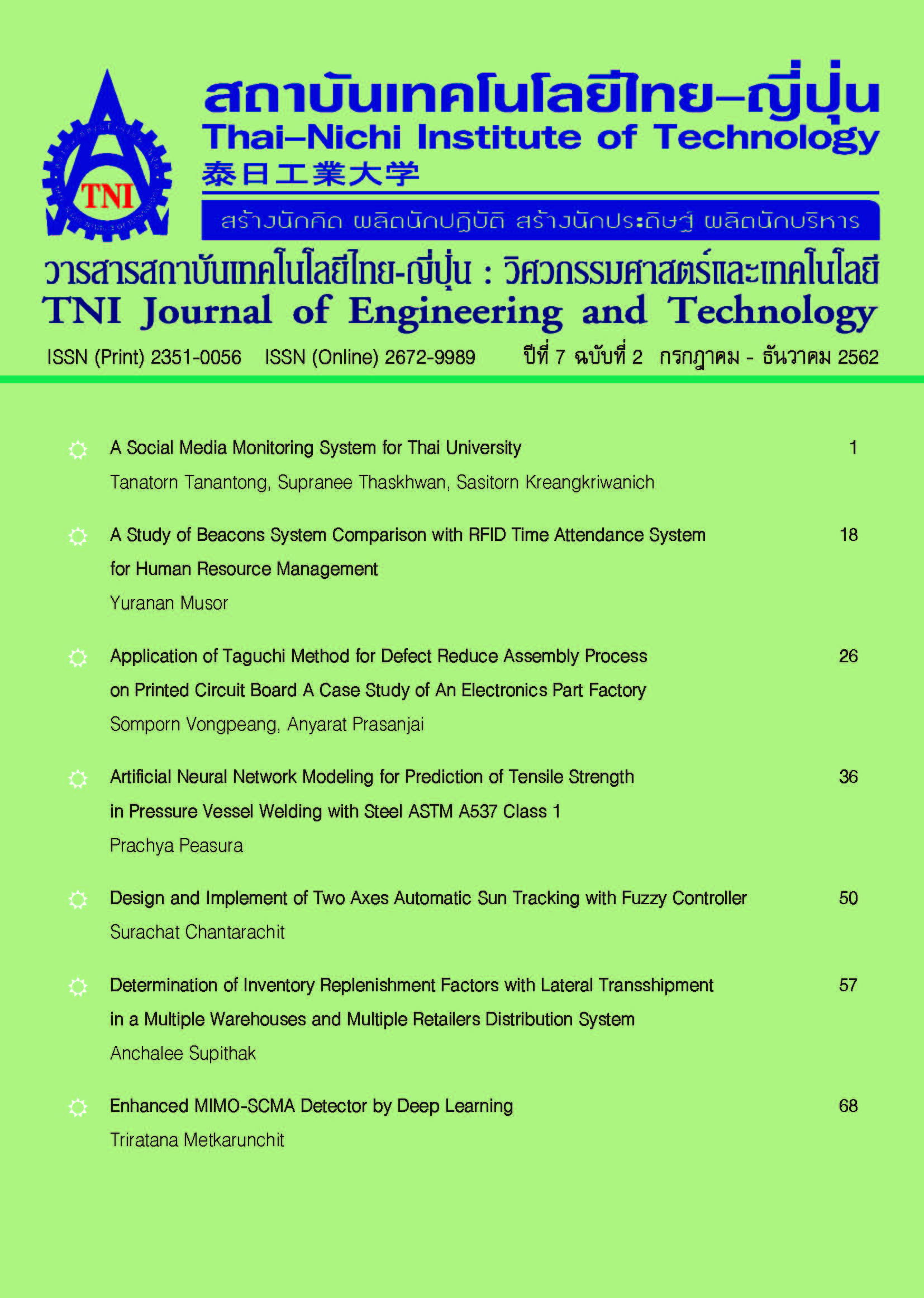Design and Implement of Two Axes Automatic Sun Tracking with Fuzzy Controller
Main Article Content
Abstract
The solar energy is widely used in Thailand. Most of all are fixed on the roof or ground. To increase efficiency of harvesting energy, two axes solar tracking is designed and constructed. The position of the sun is detected by using four LDR sensor. Those sensors are divided by partition in order to know the light direction of the sun. Those data from the sensor are sent to micro-controller to determine the motion by fuzzy controller. The rule of controller is designed to be concerning of energy consumption. Two linear actuator is applied to rotate solar panel. Both of actuator is decoupled. Fifty watts of solar panel is applied to collect the energy. The solar tracking of this research can gain more energy than fixed panel 14 percent. The experimental results are presented and compared.
Article Details
Article Accepting Policy
The editorial board of Thai-Nichi Institute of Technology is pleased to receive articles from lecturers and experts in the fields of engineering and technology written in Thai or English. The academic work submitted for publication must not be published in any other publication before and must not be under consideration of other journal submissions. Therefore, those interested in participating in the dissemination of work and knowledge can submit their article to the editorial board for further submission to the screening committee to consider publishing in the journal. The articles that can be published include solely research articles. Interested persons can prepare their articles by reviewing recommendations for article authors.
Copyright infringement is solely the responsibility of the author(s) of the article. Articles that have been published must be screened and reviewed for quality from qualified experts approved by the editorial board.
The text that appears within each article published in this research journal is a personal opinion of each author, nothing related to Thai-Nichi Institute of Technology, and other faculty members in the institution in any way. Responsibilities and accuracy for the content of each article are owned by each author. If there is any mistake, each author will be responsible for his/her own article(s).
The editorial board reserves the right not to bring any content, views or comments of articles in the Journal of Thai-Nichi Institute of Technology to publish before receiving permission from the authorized author(s) in writing. The published work is the copyright of the Journal of Thai-Nichi Institute of Technology.
References
[2] Rizk, J. C. A. Y., and Y. Chaiko., “Solar tracking system: more efficient use of solar panels”, World Academy of Science, Engineering and Technology Journal, Vol. 41, pp.313-315., 2008.
[3] Kalogirou, S. A., “Design and construction of a one-axis sun-tracking system”. Solar Energy Journal, Vol. 57, No. 6, pp.465-469, 1996, doi: 10.1016/S0038-092X(96)00135-1.
[4] Khan, M.T.A. et al., “Design and construction of an automatic solar tracking system”. in Proc. ICECE 2010 Int. Conf. on Electrical & Computer Engineering, 2010, pp. 326-329, doi: 10.1109/ICELCE.2010.5700694.
[5] S. Abdallah and S. Nijmeh, “Two axes sun tracking system with PLC control,” Energy Conversion and Management,Vol. 45, No. 11–12, pp. 1931–1939, 2004.
[6] Bingol, O., Altintas, A. and Oner, Y., “Microcontroller based solar-tracking system and its implementation”. Journal of Engineering Sciences, Vol. 12, No. 2, pp.243-248, 2006.
[7] K. K. Chong and C. W. Wong, “General formula for on-axis sun-tracking system and its application in improving tracking accuracy of solar collector,” Solar Energy, Vol. 83, No. 3, pp. 298–305, Mar. 2009.
[8] Oo, L.L. and Hlaing, N.K.,. “Microcontroller-Based Two-Axis Solar Tracking System”. in Proc. 2nd IEEE-ICCRD Int. Conf. on Computer Research and Development (ICCRD), May. 2010, pp. 436-440, doi: 10.1109/ICCRD.2010.59.
[9] Akbar, H.S., et al, “Microcontroller based dual axis sun tracking system for maximum solar energy generation”, American Journal of Energy Research, Vol.5, No.1, pp.23-27, 2017, doi:10.12691/ajer-5-1-3.
[10] Hafez, A.Z., Yousef, A.M. and Harag, N.M., “Solar tracking systems: Technologies and trackers drive types–A review”, Renewable and Sustainable Energy Reviews, Vol. 91, pp.754-782, 2018, doi: 10.1016/j.rser.2018.03.


